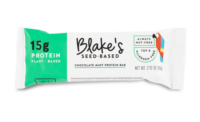Food Safety
An allergen-free warehouse
Allergen management and proper labeling are key in a company’s effort to prevent cross-contact.

The Preventive Controls regulation found in 21 CFR Part 117 mandates that food processors establish programs to manage food allergens to ensure consumer safety.
The regulation focuses on two areas: proper labeling to ensure consumers are informed of any products containing allergens and programs to minimize the potential for cross-contact. Parts of any food or beverage plant that need to have allergen management programs in place are the receiving, storage and warehousing areas. And, even though allergen management and proper labeling are only two pieces of the puzzle in a company’s effort to prevent cross-contact, they are integrated with other elements.
Receiving
Properly managing allergens starts at the receiving dock. Receiving is much more than checking the condition of delivery vehicles and making sure that they have been properly sealed.
If the vehicle inspection indicates that incoming materials are damaged or there has been a spill, there could be a cross-contact issue. The load should be held until the receiving crew, with assistance from the quality group, can determine whether there are any potential safety or quality issues.
The receiving crew will be responsible for ensuring that every ingredient and all raw material containing allergens will be properly flagged to indicate they contain an allergen. Although how this is done varies, most processors utilize a brightly colored tag that says “allergen.” The allergen tag should be unique, so it cannot be confused with any other tags used within the facility.
Allergen tags may be generated in house or purchased. Al-Aware manufactures paste-on allergen tags in different sizes that fit this need quite well. When examining the incoming allergen-containing materials, the receiving staff should also verify that the items are properly labeled. Many suppliers of ingredients and raw materials have helped processors better manage allergens by modifying packaging, so that it clearly states that the product contains a specific allergen.
The purchasing or quality group is responsible for communicating to the receiving crew which materials contain allergens. To do this, an accurate and regularly updated list of those ingredients and raw materials should be kept. This list should include the name of the supplier and the specific plant that has been approved, as all materials must come from only approved suppliers with an allergen management program.
The vendor approval program should be designed to identify any materials that contain allergens. In addition to tagging allergen-containing ingredients and raw materials, many companies require Certificates of Analysis (COAs) to be presented and properly reviewed by receiving personnel prior to accepting any delivery.
Also received at the docks are labels, which are an important part of allergen programs. The most common cause of allergen-related recalls is improperly labeled product, which often means the use of the wrong label.
Many companies have developed label management programs, which entail verifying the accuracy of each lot of labels. The receiving crew should notify the quality group when new labels are received, and these labels should then be stored in a locked or controlled access area.
Warehousing
After ingredients or raw materials have been received and labeled, they are then moved to the warehouse. In handling and storing allergens, the warehouse manager should follow programs to minimize cross-contact, which should include the following:
- Establish storage areas within the warehouse and in refrigerated storage areas for each group or groups of allergens. These should be carefully thought out to minimize the potential for cross-contact.
- Make sure that allergens are stored only on lower levels to prevent allergen-containing materials from dropping onto other ingredients or raw materials. These areas should be clearly defined and designated as containing allergens.
- Use dedicated rooms, areas and/or pallets for allergens if at all possible.
Warehouse operators should also consider using dedicated forklifts or pallet jacks when handling allergens. Or make sure that the handling devices are thoroughly cleaned after being used to transport allergens.
It is also a good idea to establish and document a program for handling partial bags, totes or containers of ingredients being stored at the warehouse. The partial container should be sealed and marked with the date the ingredient was used. It is a better idea to transfer the remaining ingredient to a plastic container that can be sealed and properly marked as an allergen, with the lot number and the date that it was used.
Some warehouse management programs factor in Work in Process or WIP, which are ingredients or finished product mixes that will be processed at some time in the future. These materials, especially if they contain allergens, must be properly stored and handled to minimize the potential for cross-contact. The use of allergen tags is an excellent tool to clearly identify these materials.
Also, cleaning must be an important part of food allergen management programs for both the receiving docks and in the warehouse. To minimize the potential for cross-contact, employees must clean all up spills, especially allergen spills, when they happen. The cleanup programs should be documented, and all workers in both areas must be trained on the process. The training also needs to be documented.
In addition, some processors have developed allergen management programs in the finished goods warehouse, which includes segregating different allergens. The products are packaged, cased, palletized and stretch wrapped. This way, there is really very little potential for cross-contact between products. A program to address any damage and to clean all spills immediately is a necessity, but segregation is not needed.
Training and education
The Preventive Controls regulation states that all workers engaged in manufacturing, processing, packing or holding food, or in the supervision thereof, must receive training in the principles of food hygiene and food safety, which includes allergen management.
Training programs should be twofold, consisting of general sessions, including new employee orientations and annual refresher sessions, as well as job-specific training sessions. The receiving and warehouse people should, therefore, be trained on all procedures in their areas designed for allergen management.
The bottom line is that the receiving crew and the warehouse staff are integral pieces in the allergen management puzzle. Allergen management procedures should be installed in those areas, and the workforce must be properly trained on those protocols.
Looking for a reprint of this article?
From high-res PDFs to custom plaques, order your copy today!






